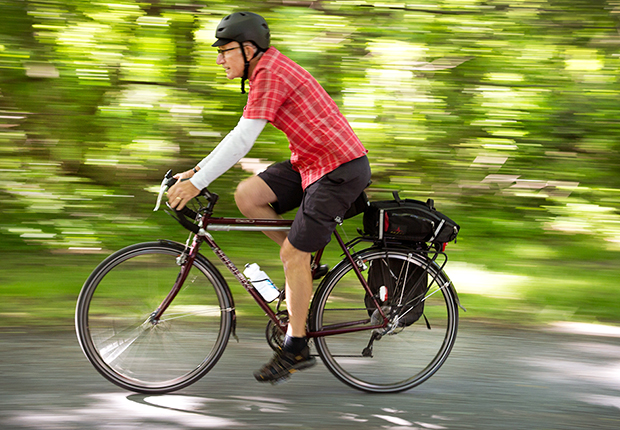AARP Hearing Center

By Thomas Ferraro
Wayne Clark and his wife, Karyn, moved from North Carolina to Maryland in 2015 largely because of his passion for biking. At 66, trim and fit, just a few pounds heavier than he was in high school, he cycles 5,000 miles a year.
“I love bicycling not only because of the health benefits, but because of the sense of accomplishment I get by traveling to places on my own power,” said Clark, a retired computer network engineer.
“Maryland is very progressive when it comes to biking,” Clark added, citing its laws, trails and attitude. “We hit a home run in picking Maryland.”
The Clarks live in Silver Spring, near a trail system that can take him to Washington, D.C., and then on to Harpers Ferry, W. Va.; Cumberland in western Maryland; and finally Pittsburgh, a ride of about 345 miles from their front door.
To the delight of bikers, including an estimated 9,000 cycling commuters—up from fewer than 5,500 a decade ago, according to the state Department of Transportation (MDOT)—Maryland has about 800 miles of bike paths, many considered among the nation’s best. They include:
- The 185-mile Chesapeake & Ohio Canal bike path along the Potomac River from Washington to Cumberland.
- The 23-mile Western Maryland Rail Trail from Fort Frederick State Park to Pearre Station.
- The 13-mile Baltimore & Annapolis Trail from Annapolis to Glen Burnie.
There are also more than a dozen highly popular annual bike rides in Maryland, according to Bike a Century, a national bike-ride directory. They include the Tour de Frederick, begun in 2010 by Neil Sandler, founder of Spokes, a cycling magazine covering the mid-Atlantic region.
"Last year, we had 650 riders," said Sandler, predicting close to 1,000 for this year’s event, set for Aug. 12-13. "Our typical riders are in their 50's, and just want to get out and have some fun and exercise."
Studies show that biking can help prevent health problems, including high blood pressure, diabetes and cancer, which helps explain why so many older Americans have taken up the recreation in recent years.
A 2015 survey by PeopleForBikes found that bicyclists age 55-plus rode more often than any other adult age group with 42 percent riding 25 or more days a year.
Emphasis on bike safety
“We consider safe biking paths to be part of a livable community,” said Nancy Carr, AARP Maryland associate state director for communications. “Biking is good for your mind and your body.”
Baltimore County’s Ateaze Senior Center has a bike program with 120 members called the Ateaze Cycling Seniors who cycle regularly, said Bob Carson, 83, of Towson, a retired gym teacher and one of its leaders.
“I went biking today with someone in their 90s,” he said. “It gets you out and moving.”
In addition to bike paths, there are hundreds of miles of bike lanes on Maryland roads.
With the popularity of biking rising sharply in recent years, so has the number of bike fatalities, from five in 2014 to 11 in 2015.
The Maryland General Assembly responded by taking several steps, including creating a task force to study bicycle safety on state highways. Kim Lamphier of Bike Maryland, an advocacy group with 6,000 supporters, applauded the state action. “As more people ride bicycles, Maryland needs to make sure that they can ride safely.”
Eric Brenner, chairman of the Maryland Bicycle and Pedestrian Advisory Committee, said “the mind-set” in Maryland in recent years seems to have changed, with state officials now often considering cyclists’ safety and access in transportation plans. “If this routine consideration of cyclists continues, this will be as big an advance as anything else MDOT does.”
The League of American Bicyclists, one of the nation’s oldest advocacy groups, begun in 1880, ranks the most “bicycle friendly” states, based on such factors as: “legislation and enforcement; policies and programs, infrastructure and funding.” In its most recent ranking, in 2015, the League of American Bicyclists ranked Maryland No. 10.
“We can do better and we will do better,” said Marty Baker, an MDOT manager. She noted that $5.2 million in state grants was awarded last year for scores of bike and pedestrian trail projects.
Clark said he welcomes Maryland’s plans, which will help him maintain his pace of biking 5,000 miles a year. “I used to do 10,000.”
Thomas Ferraro is a writer living in Davidsonville, Md.































































